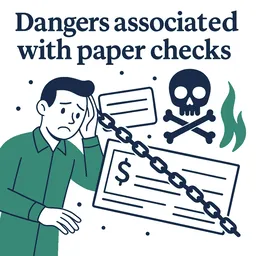Paper checks are a convenient way of paying for goods and services, however they are inherently insecure. Each check contains all the information necessary to steal money from the associated account, not just once, but any number of times as long as the account remains open. This means that anyone that has access to your school’s checks could make a copy of the account details which they could use, sell, or retain indefinitely.[^1]
Typically, a paper check will pass through many hands before it reaches the recipient. There is always a possibility that a criminal may obtain it. Criminals are targeting mail carriers and post office drop boxes in order to steal and wash checks.[^2] Even if a check is not intentionally targeted, an opportunistic thief may be tempted and steal impulsively.
A paper check continues to be a liability until it is destroyed. Banks advise electronic depositors to retain paper checks until the check clears and some time period has passed (advice varies from two to thirty days). After that, one hopes that the recipient destroyed the check, but they may keep it indefinitely if they forget.
Depending on the extent of the fraud and when it is discovered, the consequences could be significant. It takes time for banks to investigate and recover funds (if they are able to). Setting up a new account and transferring payment services to the new account takes time and effort. There could also be a loss of trust in the school, inability to access funds, cancellation of services, and accrual of unexpected fees or interest.
While security features on checks and accounts may help deter criminals or make it easier to catch them, they are not enough. Here are some ways to protect your school from check washing and theft associated with paper checks.
-
Minimize or eliminate access to paper checks associated with your school.
-
Ensure that the school’s checks are properly secured at all times. Don’t stockpile an excessive quantity of paper checks.
-
Use electronic payment methods. Pay recipients directly by eCheck, ACH, or eBill. Pay indirectly using a trusted intermediary such as the school’s bank or an enterprise payment service.
-
If a paper check is required, use a trusted intermediary to issue the check on your school’s behalf. Possibilities may include: bill pay via the school’s bank account, specialized payment service[^3], or cashier’s check[^4] via the school’s bank.
-
-
Ensure that adequate monitoring is set up on all financial accounts. Make sure your school is ready to deal with an incident if one occurs.
-
Verify that alerts are set up on accounts sufficient to detect suspicious activity.[^5] Ensure that alerts go to the correct staff including backups in case someone is out of office. Make sure everyone understands what the expectations are on reviewing alerts including who is the primary person, who is backup, and how to escalate concerns within your school staff.
-
Make sure that your school is prepared to report fraudulent activity quickly in order to reduce the financial impact of unauthorized activity. Prepare or update a plan to handle this bad day situation. This should include roles and responsibilities (primary and backup reporters), reporting information for the bank, a list of who needs to be notified post-report, and a list of additional actions required. Review the plan with stakeholders and address any concerns.
-
-
Make sure that your school is taking steps to protect paper checks that may be received from from parents, benefactors, or others.
-
Ensure that the rules for accepting paper checks and mail (which may contain checks) are established and well known to school staff. Minimize access to checks so they are less likely to be lost or stolen.
-
Encourage electronic payments instead of paper checks to the school. If your school is not already using electronic payments, they are easy to set up and have numerous benefits. These benefits include automatic deposits, automatic receipts, automatic ledger entries, and no paper checks to handle or store. Fees are modest (especially for ACH) and payers are often open to paying more for the flexibility of electronic payments.[^6]
-
References
[^1]: Checks and check fraud: occ.gov nerdwallet.com
[^2]: Check fraud related to mail theft in recent news: fincen.gov cbsnews.com latimes.com usatoday.com
[^3]: An example payment service offering paper checks: bill.com bill.com
[^4]: Cashier’s checks: usnews.com helpwithmybank.gov
[^5]: Bank alerts: experian.com
[^6]: An electronic payment processor service: stripe.com stripe.com stripe.com
